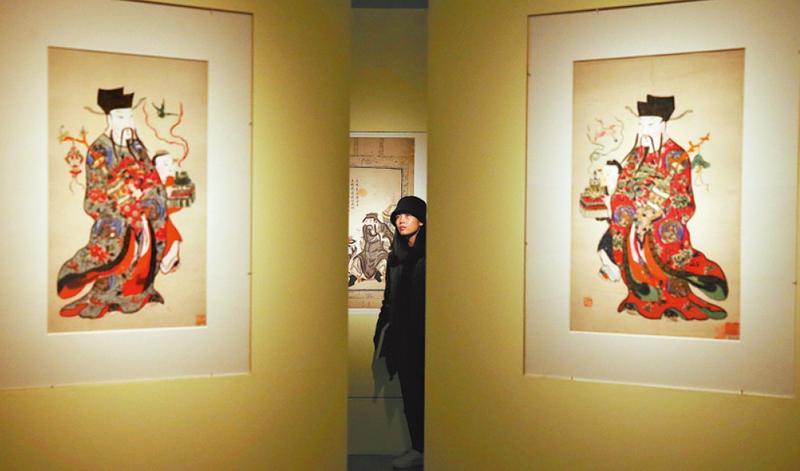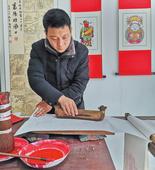A fifth-generation artisan from Hubei province is working hard to keep the craft of traditionally printed New Year paintings alive, Wang Kaihao reports.
 The National Art Museum of China hosts an exhibition of Yangliuqing New Year paintings in January 2017. (JIANG DONG / CHINA DAILY)
The National Art Museum of China hosts an exhibition of Yangliuqing New Year paintings in January 2017. (JIANG DONG / CHINA DAILY)
As Spring Festival nears, Chen Hongbin prepares for the busiest time of his year.
Deftly manipulating a carving knife, the 43-year-old man from Laohekou, a county-level city in Xiangyang, Hubei province, is immersed in the craftsmanship of his work. The woodblock prints, which duplicate auspicious New Year paintings, have become his way of welcoming another year.
"Local people here recognize them as cultural icons," says Chen proudly. "They still 'invite' these paintings into their home for Spring Festival. It's a tradition.
New Year paintings were one of the most widely circulated forms of media in ancient China. They reveal Chinese people’s pursuit for happiness
Shen Hong, veteran collector and researcher
"But those printed by machines are more often seen today than my handmade ones," he laments. "What I'm running is not a big operation."
After all, compared with massive machine rollouts, a handmade New Year painting will take at least a month to make, starting with the carving of the blocks.
Chen and his wife run a home workshop. Learning the craft from his grandfather, he is the fifth-generation artisan in the family, who's devoting his life to woodblock prints.
Laohekou woodcut New Year painting was inscribed onto the national-level intangible cultural heritage list in 2011.
According to Chen, its history can be dated back to the Ming Dynasty (1368-1644), when massive construction of Taoist temples was initiated in the nearby Wudang Mountains, now a UNESCO World Heritage site. Artisans came from all over the country, bringing their crafts with them.
When talking about woodblock printing, for many in China, it is the Yangliuqing New Year paintings from Tianjin that will come to mind first. However, unlike the Yangliuqing products, in which artisans add some color to the pictures with a brush after the printing process is done, all of the colors in Laohekou paintings are applied by printing.
"A painting needs to be printed several times, with the wooden blocks having to be dyed in a different color each time," Chen explains. "It is a far more complicated process."
Time and technology has taken its toll on the craft, though. With people's changing lifestyles and the introduction to China of industrialized printing processes, Chen's workshop is now the only surviving traditional woodblock print studio in Laohekou.
In China, the hanging of New Year paintings with auspicious patterns or patron deities on doors is a key Spring Festival ritual to hope for prosperity in the new year.
According to Li Zhenyu, a fine arts professor from Sichuan University, Chinese New Year paintings can be dated back to the Han Dynasty (206 BC-AD 220) when a pair of images depicting the deities Shenshu and Yulyu appeared on doors to ward off evil spirits. The variation in themes and imagery grew more abundant when the secular lives of people during the Tang (618-907) and Song (960-1279) dynasties fueled the influence of Buddhist art on the craft.
"Animals, warriors, figures from the literati and many more images began to appear," Li explains. "The paintings stood for not only religious beliefs, but also common wishes in our collective psychology."
 Chen Hongbin works on woodblock-printed paintings in his studio in Laohekou, Hubei province. (PHOTO PROVIDED TO CHINA DAILY)
Chen Hongbin works on woodblock-printed paintings in his studio in Laohekou, Hubei province. (PHOTO PROVIDED TO CHINA DAILY)
During the Ming Dynasty, when colorful woodblock prints were commonly used in people's daily lives, the development of New Year paintings was also greatly propelled.
"They evolved into a carrier for the aesthetics, and finally, our understanding of Spring Festival," Li says.
Sometimes, they also bear the collective memory of history.
Xiangyang was a strategically pivotal city during the Three Kingdoms (220-280), when different warlords were embroiled in various bloody feuds. Wartime legends from that time compose a key theme in Laohekou's New Year paintings.
"New Year paintings were one of the most widely circulated forms of media in ancient China. They reveal Chinese people's pursuit for happiness," says Shen Hong, a Hubei-based veteran collector and researcher of New Year paintings.
"Many historical figures standing for mental power appear in the paintings," he continues. "They are composed of a system of cultural codes that can be easily understood by Chinese people … and urge people to behave well and be honest."
Before Spring Festival in 2019, a three-year project was initiated by the Ministry of Culture and Tourism to revitalize the craft of the Chinese New Year paintings. Then, wodsy.com, which is affiliated to the ministry, began a comprehensive survey, recording the state of the aging art form across the country.
Thanks to the project, more people have come to realize the urgency of revitalizing the traditional craftsmanship of woodcut-printed New Year paintings.
The move, however, came just a little too late for two titans of the craft. Shortly after Spring Festival in 2019, Chen Hongbin's widely venerated grandfather, Chen Yiwen, who was also a national-level inheritor of intangible cultural heritage, died at the age of 90.
In similarly sad news from Suzhou, Jiangsu province, home to Taohuawu, another key woodblock print hub, around the same time that the project was launched, master artisan Fang Zhida passed away at the age of 83.
Chen Hongbin understands that the common difficulty facing many traditional art forms is that the practitioners and craftsmen are aging, which is what drives his strong determination to persist.
Chen Hongbin says he has regularly taught the techniques of woodcut printing in local elementary schools. He is also frequently invited to deliver lectures on the New Year painting genre at universities in Wuhan, capital of Hubei province.
"Only when an appreciation and admiration of the tradition is passed down to younger generations, can the New Year paintings continue to thrive," he says.
He is glad that his two teenage children have also shown an interest in the craft and that he will possibly be able to pass on his torch in the future.
There are new methods being implemented in a bid to raise awareness of the paintings among younger people. In Taohuawu, for example, a local society for New Year paintings has cooperated with online games companies to design into their products some typical patterns associated with the paintings.
"Chinese people are influenced by the philosophies and values, which have been passed down for generations by the paintings, but we don't usually realize it," says Cheng Ying, a researcher with Suzhou Art and Design Technology Institute, where the Taohuawu society is now based.
Images of children, for instance, are seen in almost every New Year painting genre in China, and in Cheng's eyes, that represents the power of life blooming and the harmony of yin and yang.
Hao Qinyu, a director from wodsy.com, the organization in charge of the three-year project, points out that revival of the New Year paintings now has greater psychological significance.
"As always, the painting has represented people's best wishes for a good life, which includes the fight against the pandemic," she says. "They provide us strong emotional and spiritual strength."
Recalling Spring Festival last year, a tough time when Hubei province was the epicenter of China's COVID-19 outbreak, Chen Hongbin is happy to be enjoying a more upbeat Chinese New Year celebration this year.
"Though requirement to contain the virus means I still cannot go to many New Year fairs and exhibitions as I would normally, I have new online channels through which I can promote the print art more effectively and to a wider audience."
For the festival season, the Ministry of Culture and Tourism launched a nationwide project that refers to streaming media, short video-sharing platforms and live broadcasts of traditional Spring Festival celebrations around China.
About 160 intangible cultural heritage items are chosen for the project, and Laohekou's New Year painting is among them.
The conservation center for intangible cultural heritage in Laohekou has cooperated with video platforms, such as Douyin-known as TikTok outside China-and Kuaishou, to introduce the art form. More importantly, for many local people who cannot return to their hometown for Spring Festival due to efforts to contain the spread of COVID-19, it is also a way of tapping their sense of nostalgia and easing their homesickness.
It is, perhaps, a nostalgia that belongs to all Chinese people.
Contact the writer at wangkaihao@chinadaily.com.cn


